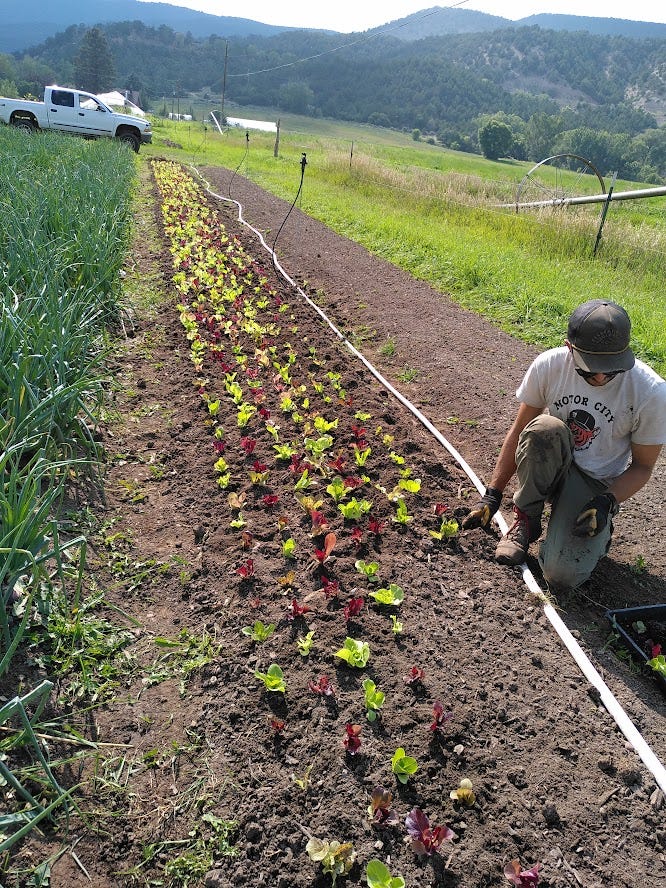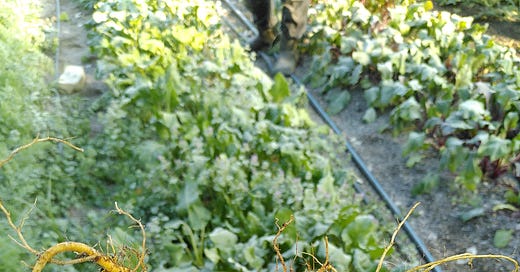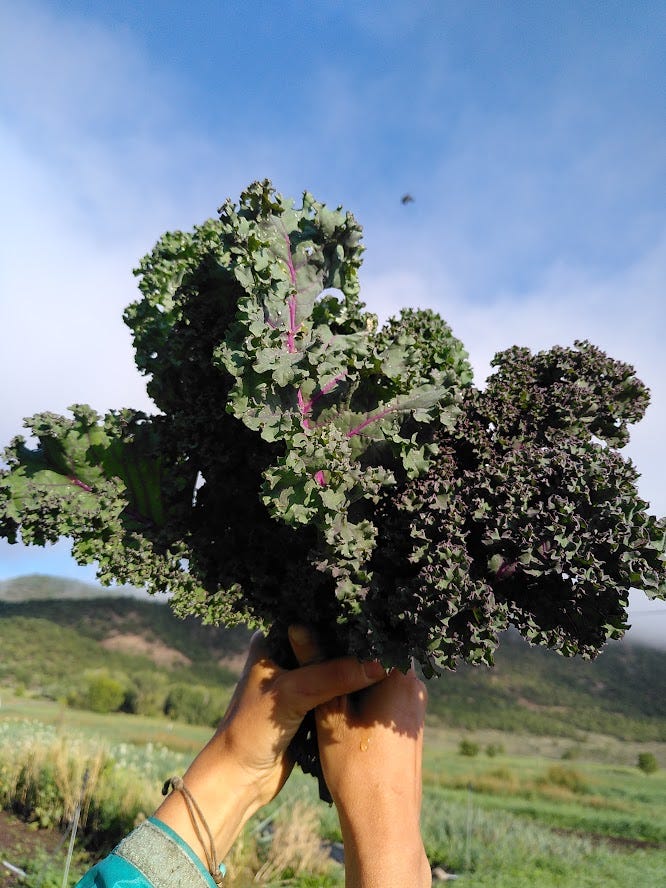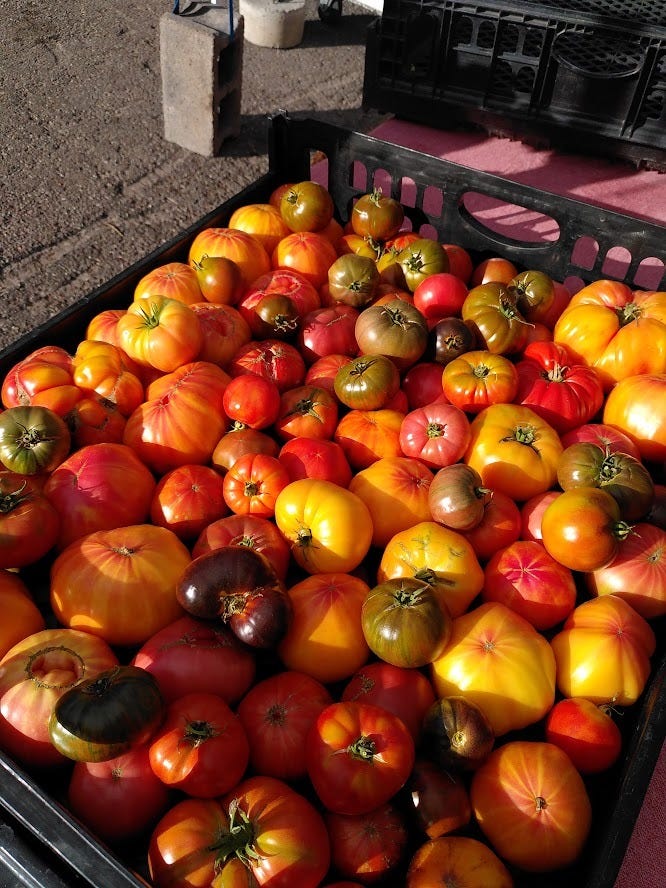Hello again. Here’s some unscheduled chatter, which I am endeavouring to do more of this year. Not just week-by-week reporting of starting a regenerative agriculture business with my partner, but also the thoughts that come up from it.
This particular piece is inspired by a recent (but also recycled) post from
about feeding ourselves out of our vegetable gardens. It’s well worth a read.What this piece brought up for me, and lead to a lively discussion with my partner, is how much farmers want you to grow your own food.
Let’s give a little backstory here. Let me list my credentials.
Over the past four years, I have been training on various vegetable farms to get to the point where I am now. Over this time I have taken every opportunity to talk to other farmers, to learn from them. Something I will continue to do. To exchange ideas (and recipes) and insights. To soak up all the information I can, to lead towards this very moment. I have trained, read, practised, took on more and more responsibility. For the past two years my partner and I managed an organic vegetable farm. And here we finally are, starting our own.
But throughout this time I have often discussed with other farmers what they like growing, and what they wish people grew more of.
The food system, as it is, here in the US and back home in the UK, is pretty wack. Or, in fact, out of wack. It’s cheaper to fly, boat and drive in food than it is to purchase from local farmers or even to grow your own. It often makes me think of this meme.
It gets me every time.
But as
and this delicious meme point out, there is a cost associated with growing your own food. It’s not as simple, or as cheep, as just putting some seeds in the ground. Even if the main cost is often time.But of course, there is also the sheer joy of growing your own food, which one cannot put a price on.
That is to say, there are many sides to this.
I also want to mention a good-ol’ piece from
on how much space it takes to grow your own vegetables. She does some wonderful calculations on how much space you would need for a pound of produce per day. I honestly have so much love for the people trying to look at the problem of our food system head-on, and to give tangible and calculatable solutions.While I agree that producing your own vegetables is vital, I find it pretty unrealistic to expect people to grow all their own food. Especially those who are looking down the barrel of sanctions and food shortages, or at the very least heightened food insecurity. To go from 0 to 100, to do so in times of housing insecurity.
It is unwise and honestly dangerous misinformation, to tell people to just grow a victory garden and they will weather the storm coming our way.
Not that Sue is doing this, I am 100% behind her calculations and her calls to grow your own.
But in this, I acknowledged that many people do not have the resources to grow their own food, to buy local produce, to find fresh vegetables within an accessible distance. And in this way I am willing to be a traitor to my profession.
I think people should grow more of their own food.
As a farmer, I encourage people to grow more of their own food.
This may seem counter-intuitive. As if I’m chasing away customers. But my reaosns are threefold.
Economies of Scale
For a lot of crops, it will be cheaper and more efficient for me (a farmer) to grow them at a much larger scale than a kitchen garden. This is true of things like lettuce, tomatoes, garlic and onions.
For an individual to have just one head of lettuce every week for most of the growing season you would need to plant at least 30 heads. And for things like lettuce, you can’t plant them all at once. To get a consistent flow of lettuce you would have to plant a couple of plants per week for 15+ weeks. You would have to have the space for that in your garden, the schedule to start a couple of seeds each week or, even more expensively, to buy regular transplants. A constant supply of lettuce is no mean feat for a home gardener.
Whereas farmers, even ones on a small scale, can easily plant 800 lettuce heads every other week (that’s one standard 100’ bed spacing the lettuces in 4 rows 6” apart). A farmer can provide enough salad for 400 salads a week. Maybe 300 to account for spoilage and pests and people not really feeling salad that week. But that’s enough to keep you (and 299 others) in salad for the whole growing season, for as little as $2 a head.

The same principle applies to root crops; carrots, daikon, turnips, beetroot, and radishes. A 100-foot bed, which is tiny on the farming scale, can produce at least 120 bunches of carrots. Planted consistently a farmer can provide roots at a scale that is hard to replicate in the home garden.
Or grains, or dried beans, you’re going to need a couple of acres grown collectively to get you enough to live on. And that’s fine. It’s not impossible, as shown by the phenomenal Homegrown and Hand-gathered, but it sure isn’t the easiest.
I say all this not to discourage you, but to point out the case where a farmer would be the ideal person to grow salad or root vegetables for a community instead of each member growing them for themselves.
On the other hand, some plants are easier to tend at a kitchen garden scale: collards, chard and kale. Here a couple of plants are all that are needed to keep your household stocked with greens for as long as the plants can grow. I would absolutely love it if more of our customers grew their own hardy greens. I would feel no remorse hearing that’s what they were doing instead of buying ours.
This is also true for peas. For the love of all that is holy, please grow your own peas. They are so hard to make commercially viable, but so delicious. On each farm I’ve been on they are grown for love, not money.
Or microgreens. Ah, the list goes on!
This may sound like I’m turning away my own customer base but this couldn’t be further from the truth. For one there will always be people without growing space and I’m happy to provide for them. For two, many people might find they don’t like growing certain vegetables, they won’t know that unless they try. And vitally, getting to talk to people about what they are growing is always exciting! This leads me to the next point.
Encouraging Resilience
Taking a chance on a new variety is not usually at the top of a busy farmer’s list of things to do that year. Not unless the seed has mysteriously become unavailable (I could rant on that later) or if they have had a particularly strong recommendation from another local farmer. But the joy of a home garden is that you get to try all the wonderful and weird varieties that farms don’t usually have the chance to grow.
Personally, while I’m also planning a whole farm, I am also shopping for grexi (grexes?) and cool breeding stock from the Experimental Farm Network for my personal garden.
By growing a wide variety of plants and even members of the same species in a bioregion we build resilience into the local food system. The more we experiment with varieties, the greater chance there is that something will adapt to the changing climate. Home gardens and small diversified farms are at the forefront of protecting genetic diversity and thus climate resilliance.
Resilience is not just found in the varieties we choose to grow but in many people growing many things all at once. If a farmer has a crop failure, which is becoming more likely within our collapsing climate, having a home garden is a backstop. A fallback.
So not only do home gardeners get to experiment, to have more options in the case of disruptions to the food system but they also get to learn a vital skill. When we learn to grow food, as
pointed out in their piece on Behavioural Cusps (or gateway hobbies), we open the door to preserving, learning new varieties, to noticing the local fauna that eats our crops too. Growing food is a gateway to a realm of knowledge; a great inspiration.The more people that know how to grow food, the better equipped our communities will be to weather the coming chaos.
Abundance
There have certainly been times in my life where I have caught myself in the capitalist trap of ownership, of gatekeeping, of scarcity. But if working with the land, with the non-human beings and the changing seasons has taught me anything it’s that when we move from abundance shit just works better.
I could spend my time opining about how home gardens are going to put small farms out of business. Or I could look at the shattered food system and think farms of every scale and home gardeners are all essential parts of transforming this broken system. By tapping into the knowledge of local people, into the passion of hobbyists and connecting with the sheer joy of growing, we might make something better.
When we move from a place of enough, which is I’m sure going to get harder and harder, we have the chance to provide for ourselves and others. Tomato plants don’t worry that the plant next to them is also producing pounds of delicious fruit, they just make their own. Giving freely and in return we (hopefully) save their seeds. We enjoy their bounty, we tend to them.
This sounds very woo-woo, I know. But moving from a place of abundance, a place of enough, has helped me to not see myself as a lone fighter in the saving of our food system (a very white saviour thing to think, honestly), but as a small part. A tiny mushroom in a lively mycelial network.
If encouraging people to grow their own kale loses me a couple of kale sales, so be it. If those people eventually come back and tell me a new method for keeping pests away, if they share some saved seed, and some insight, then it will be worth it. If they come back in a year and say they don’t love growing kale but want to buy it- now they know what goes into keeping the plant happy and pest-free- great. If they never come back but buy a couple of seedlings in the spring and encourage their friends to grow their own, also fine.
This isn’t about winning. This is about working together.
Overall I think there is a place for each of us in transforming our food movement. Within ecosystems, diversity is essential for survival. By growing your own food you are adding to the rich tapestry of your local food system. You can steward unexpected varieties, can experiment and provide for yourself and your neighbours. But if you don’t have the time or the capacity, or the money to grow your own, there is no shame in it. Local farmers want to provide you with fresh affordable produce. There is room for us all in this. In fact, we are all vital components of this tangled food web.
Ok, that’s my diatribe over.
I’m more excited than ever to get growing and will be sending out updates soon-ish.
See you on the flip side,
M
Find me on Instagram, The Dots and my Website.
To support my work, please consider buying me a Coffee.
If you missed the last update, read it here:




















Share this post